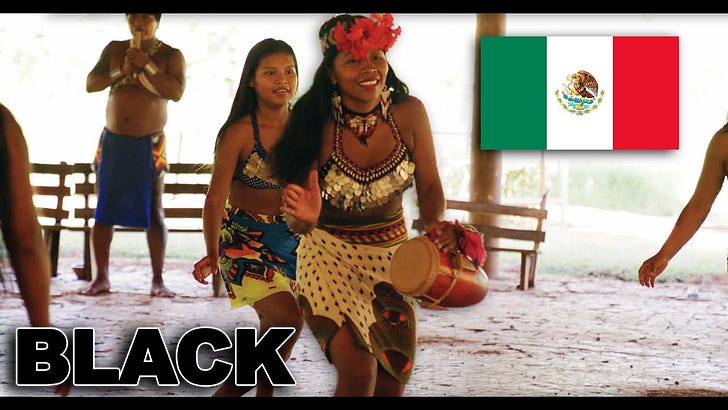The History and Legacy of Afro-Mexicans
I recently wrote an article on why I think Mexico is the top choice for Black Americans seeking a second passport.
Black America: Passport Plan B - Mexico
Times are changing fast, and a lot of people are waking up to the idea that a Plan B passport isn’t just for tax dodgers or conspiracy theorists. For Black Americans, having a second passport means more than just an “escape route" it’s about options, freedom, and living life on your own terms.
My personal stance is that everyone should have an opportunity to get a second passport. There are already dozens of articles on how White Americans can gain residency in multiple European countries through parents, grandparents etc. These options aren’t available to Black Americans. I don’t believe in gateholding or racism towards ethnic groups. I personally think it's wild that some people can be discriminatory while moving to a region where they often discriminate against people.
It turns out that I got a lot of DMs on the subject and decided to put my interest in history to use in writing this article.
When considering the African diaspora in the Americas, the conversation often centers on the United States, the Caribbean, and Brazil. Yet, Mexico, too, has a rich and complex African heritage woven deeply into its social, cultural, and historical tapestry. While Afro-Mexicans have not always been as prominently recognized as other groups, their presence is neither recent nor marginal—it dates back centuries, starting under Spanish colonial rule and evolving through independence, revolution, and modern identity movements.
Today, Afro-Mexicans are increasingly gaining recognition within Mexico’s multicultural landscape. Their communities, primarily concentrated in coastal regions like the Costa Chica of Oaxaca and Guerrero, and historically significant towns like Yanga in Veracruz, reflect a legacy of endurance, cultural fusion, and adaptation. They also represent a continuity of African presence in North America that may surprise Americans unfamiliar with Mexico’s ethnic diversity.
Understanding this background has become more relevant than ever for Black Americans contemplating a second passport or residency abroad. Mexico’s growing openness, cultural vibrancy, and evolving acknowledgment of its Afro-descendant communities illuminate a narrative that resonates powerfully with those seeking new horizons—both socially and geopolitically.
The Arrival of Africans in Colonial Mexico
Africans arrived in Mexico primarily through the transatlantic slave trade under Spanish colonial rule. Beginning in the early 16th century, Spanish colonists, having subdued the Aztec empire, sought to exploit the region’s resources. Indigenous populations, decimated by war, disease, were insufficient for the colonists’ economic plans. Thus, Africans were brought to what was then called New Spain to labor in silver mines, sugar plantations, cattle ranches, textile mills, and large agricultural estates known as haciendas.
Enslaved Africans arrived through ports like Veracruz on the Gulf Coast, but they were not confined to one region. They spread across the colony—from the Pacific coasts to central highlands—integrating, mixing, and influencing local culture. Over time, the African presence melded with Indigenous and European elements, giving rise to new ethnic identities, languages, musical forms, religious practices, and culinary traditions.
The Caste System and Social Hierarchies
Colonial Mexico was structured by a rigid caste system—a hierarchy that placed peninsular Spaniards at the top, followed by criollos (American-born Spaniards), mestizos (mixed Spanish and Indigenous), mulatos (mixed Spanish and African), zambos (mixed African and Indigenous), and various other categories, each nuanced with socio-racial implications. Africans and their descendants frequently occupied lower tiers in this hierarchy, though some managed to gain freedoms, accumulate wealth, or rise socially through strategic marriages, manumission, and entrepreneurship.
Nevertheless, the caste system meant that African identity was often hidden, diluted, or legally categorized under umbrella terms that obscured distinct African lineages. Over generations, some Afro-descendants “passed” or were absorbed into mestizo communities. In other cases, entire African-heritage communities maintained distinct cultural practices but were rarely acknowledged in the national narratives that emerged after independence.
Resistance, Maroons, and the Legend of Yanga
Not all Africans or their descendants accepted enslavement. Resistance took many forms—from day-to-day acts of sabotage to outright rebellion. One of the most emblematic stories involves Gaspar Yanga, an African who led a group of maroons (escaped slaves) in the highlands of Veracruz. In 1570, Yanga, reputedly of West African royal lineage, escaped bondage and built a palenque—a fortified community of runaways—hidden in rugged terrain.
For decades, Yanga and his followers resisted Spanish attempts to recapture them. Eventually, negotiations led to the recognition of their freedom and the establishment of a free town in 1618. This town, known today as Yanga (in Veracruz), is widely considered the first free African settlement in the Americas. Yanga’s legacy is monumental: it stands as a testament to African resilience and autonomy on Mexican soil.
Liberation, Independence, and the African Legacy
By the early 19th century, Mexico’s struggle for independence from Spain intertwined with evolving notions of citizenship and equality. Mexico, after gaining independence in 1821, moved relatively quickly (by the standards of the era) to abolish slavery. In 1829, under President Vicente Guerrero—himself of mixed African descent—Mexico formally abolished slavery, decades before the United States did the same. Guerrero’s African lineage is often understated in official histories, but his presidency underscores the Afro presence in shaping the young republic’s identity.
Yet, the African influence on Mexican culture continued to fade into the broader mestizo narrative over time. The mestizaje ideology—promoted after the Mexican Revolution (1910-1920)—celebrated the mixture of Indigenous and European heritage, often neglecting the Africans. As a result, Afro-Mexicans were, for much of the 20th century, invisible in the national discourse, despite their undeniable historical roots.
Afro-Mexican Communities: From Colonial Ports to Coastal Enclaves
To understand Afro-Mexicans, one must look at specific regions:
Veracruz: Besides Yanga, the entire Gulf Coast region once bustled with enslaved Africans. Though the African presence later blended into the general population, certain towns still remember their Afro roots in festivals, religious customs, and oral histories.
Guerrero and Oaxaca (Costa Chica): Perhaps the most iconic modern Afro-Mexican communities exist along the Costa Chica, a coastal strip extending from southern Guerrero into western Oaxaca. Here, Afro-Mexicans have retained distinct musical forms (like chilena music), dances, and culinary traditions that reflect African, Indigenous, and mestizo blends. Villages such as El Ciruelo, Pinotepa Nacional, and Cuajinicuilapa are centers of Afro-Mexican heritage.
La Huasteca and Other Pockets: While the Costa Chica and Veracruz remain the most studied areas, Afro-descendant populations have also existed in various parts of the interior. Over centuries, some Afro-Mexicans migrated, integrated, or disappeared into mestizo populations. Yet, genetic and cultural traces remain, reminding us that African heritage was never confined to a single region.
Norteño Regions and Escapes from the U.S.: Interestingly, Mexico’s stance against slavery and its relative freedoms attracted African Americans seeking refuge in the 19th century. Some fled the American South and crossed into northern Mexico. Communities emerged where African Americans intermarried with local populations, forging Afro-Mexican lineages in states like Coahuila and Tamaulipas. The descendants of these settlers add another dimension to Afro-Mexican history, linking it to the broader African diaspora’s search for freedom.
Cultural Intersections and Expressions
Afro-Mexican culture is not monolithic. It varies widely from region to region, influenced by local Indigenous groups, environmental conditions, and economic opportunities. Some distinct cultural expressions include:
Music and Dance: Afro-Mexican communities in Costa Chica often engage in dances and musical traditions traceable to African rhythms—though now thoroughly “Mexicanized.” The chilena dance, for instance, possibly arrived via Chilean sailors but flourished under Afro influence. The result is an intricate cultural mosaic that blends African drumming patterns (long since adapted to local instruments) with Indigenous and Spanish musical idioms.
Cuisine: While mainstream Mexican cuisine is celebrated worldwide, Afro-Mexican communities add subtle variants—seafood dishes, plantain-based recipes, or cooking techniques that whisper of African ancestry, though often without explicit acknowledgment. Food becomes a living archive of history.
Religious Syncretism: The Catholic faith, brought by Spaniards, overlaid Indigenous and African spiritual frameworks. Afro-Mexican religious practices sometimes incorporate subtle elements reminiscent of African spiritual traditions—perhaps in the rhythms of religious festivals or the communal reverence of certain saints known for miracles and protection.
20th Century Invisibility and Recent Recognition
For much of the 20th century, Afro-Mexicans remained a forgotten chapter in Mexico’s racial narrative. The official story emphasized mestizaje—Indigenous and European mixture—as the core of national identity. African roots were scarcely mentioned, and many Afro-Mexicans themselves, facing social pressure, either assimilated or did not emphasize their Blackness.
However, the late 20th and early 21st centuries brought renewed scholarly interest. Anthropologists, historians, and activists began highlighting Afro-Mexican histories, spurred by global movements advocating African diaspora recognition. Academic conferences, cultural festivals, and grassroots organizations in places like Cuajinicuilapa’s Museo de la Tercera Raíz (Museum of the Third Root) have emerged, celebrating Afro-Mexican heritage and educating locals and visitors alike.
Constitutional Recognition and Identity Politics
A significant milestone occurred in recent years: the Mexican government began officially recognizing Afro-Mexicans as a distinct ethnic group. In the 2020 census, for the first time, Mexicans could self-identify as Afro-descendant. Over two million people (around 2% of the population) did so, shattering the myth that Mexico’s African presence was negligible. This official acknowledgment paves the way for policies addressing historical discrimination and underrepresentation and for fostering cultural pride within these communities.
Afro-Mexicans and the Global African Diaspora
As global conversations about the African diaspora deepen, Mexico’s Afro-descendants are claiming space in that dialogue. Scholars and cultural ambassadors link Afro-Mexican traditions to those of Cuba, Haiti, Colombia, and Brazil, situating Mexico firmly in the mosaic of African-influenced American societies. Festivals celebrating African roots attract international visitors, and collaborations with other Afro-Latin communities spark transnational cultural exchanges.
Resonances for Black Americans Seeking a “Plan B” in Mexico
For Black Americans weighing Mexico as a “Plan B” for a second passport or residency, understanding Afro-Mexican history brings a richer sense of belonging and continuity. While Mexico does not have the large, visible Black communities of the U.S. or the Caribbean, its Afro communities underscore a point: African heritage in the Americas is universal and longstanding. This heritage also demonstrates that Mexico has historically been a haven for people fleeing enslavement and racism—be they Africans brought by the Spanish or African Americans escaping U.S. slave states.
In present times, as Mexico gradually acknowledges Afro-Mexicans’ place in the national narrative, new alliances and communities of interest form. Black American expatriates might connect with Afro-Mexican cultural centers, partake in community festivals along the Costa Chica, or engage with academic initiatives exploring African diasporic links. This convergence can enrich the “Passport Plan B” experience beyond mere legal status—offering cultural resonance and potential solidarity.













